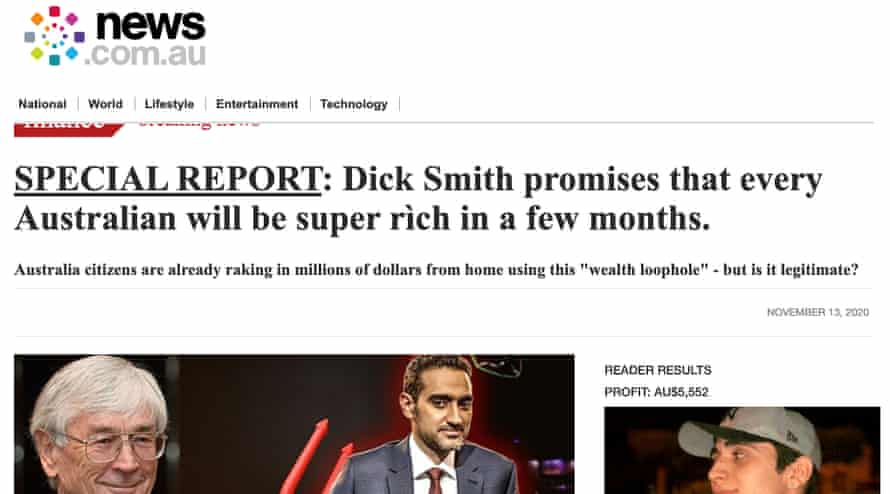The Australian billionaire Andrew Forrest has launched criminal proceedings against Facebook for failing to take action on scam ads featuring his image. A Guardian investigation into the scam ads sheds light on how the scam works and what the ads look like.
What are the scam ads?
The ads appear on Facebook or on news sites as “programmatic ads” supplied by Google. Programmatic ads target individual users.
These ads use images of celebrities or other well-known people in the regions they are targeting, such as Forrest or Dick Smith in Australia. They are presented as a news story claiming the celebrity has made a “big investment” and the banks are shocked by how well it is doing.

If you click on the ad, it takes you to a fake news story that includes a link claiming to be a cryptocurrency investment scheme. If you enter details to register for the scheme, you receive a phone call typically asking you to invest a small sum, such as US$250. You are then asked to invest increasingly larger amounts.
In one case that Guardian Australia previously reported, a 77-year-old Queensland grandmother clicked through from a Facebook ad featuring Forrest. She initially transferred $5,000 to a cryptocurrency exchange before being encouraged to put in more of her money. Scammers eventually emptied her accounts, stealing her entire life savings of $80,000. She was unable to get her money back.
Some of the scams encourage people to invest in highly risky and often unregulated forex trading platforms where they are likely to lose most, if not all, of their money. The worst of the scams encourage people to hand over more and more money in an attempt to get their initial investment back, leading them to greater losses.
An international investigation by the Organized Crime and Corruption Reporting Project reported that contact details of people who signed up for such services were also passed on to brokers offering other risky or illegitimate investments.
These scams accelerated during the initial phase of the Covid-19 pandemic.
Why have these ads been so hard to stop?
The normal approach to stopping these sorts of ads is to block the website hosting them, or by looking for specific “keywords” in the ad text and banning those from being used. Google said in 2019 it removed about 5,000 ads a minute, or about 2.7bn in a year.
But it is a game of cat and mouse. The scammers change ad text frequently to evade capture and to avoid domain blocking. Using a variety of domain registration companies, they buy hundreds of domain names every month to host the pages that users are directed to when they click on the ads.
If you are viewing the scam websites outside the targeted location, they can look like innocuous sites for cooking, or gardens or fruit.
Who is behind the ads?
The investigation by Guardian Australia found that hundreds of these sites were registered under just five names, all with addresses in the centre of Moscow.
None of those listed on the registration forms responded to attempts to contact them.
The scams may also be based in Ukraine, as the scam sites do not allow people to register a phone number form there. A previous OCCRP investigation found a call centre running similar celebrity-based investment scams operating from the nation’s capital, Kyiv.
Have the regulators done anything about it?
In Australia, regulators have admitted it is difficult to trace and stop these scams. A spokesperson for the Australian Competition and Consumer Commission said the ads had been traced back to overseas. The ACCC had managed to get a handful of the sites removed by contacting the domain hosts.
In the UK there has been more success, in large part due to a dedicated site where the public can report suspected scam websites. The country’s cybersecurity agency removed over 731,000 celebrity scam sites between April and December 2020.





